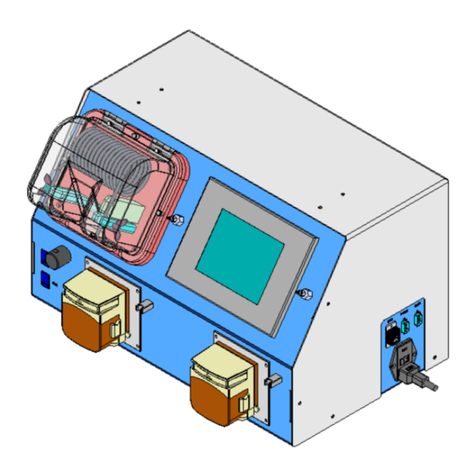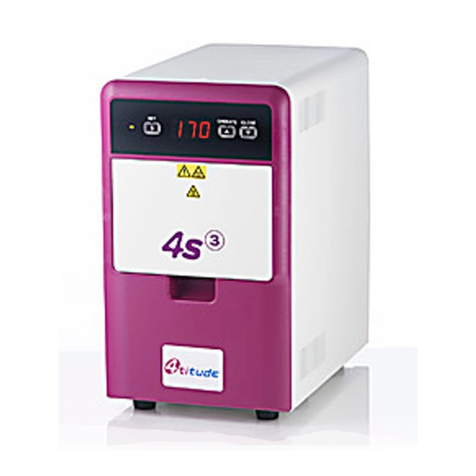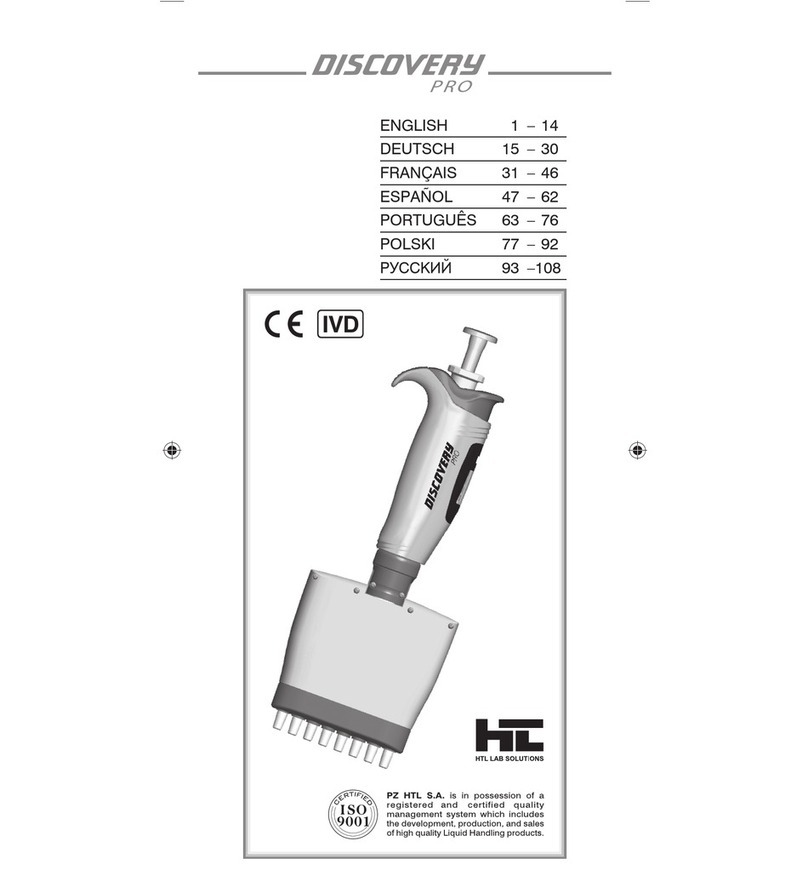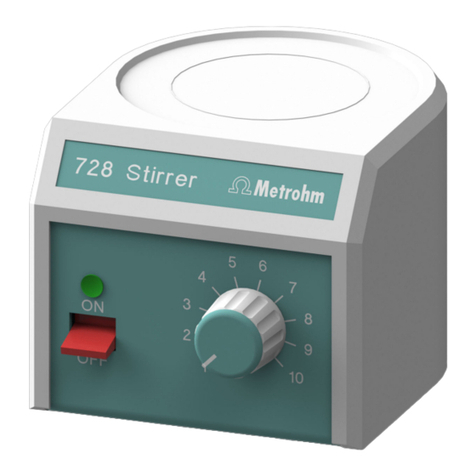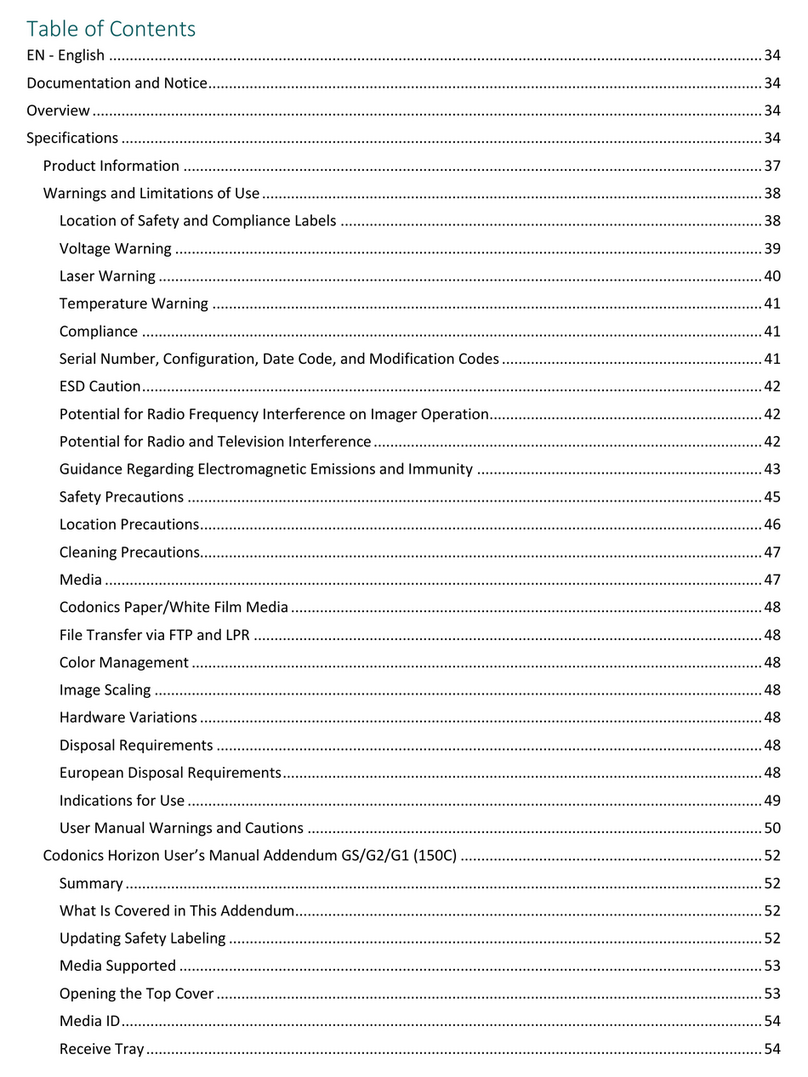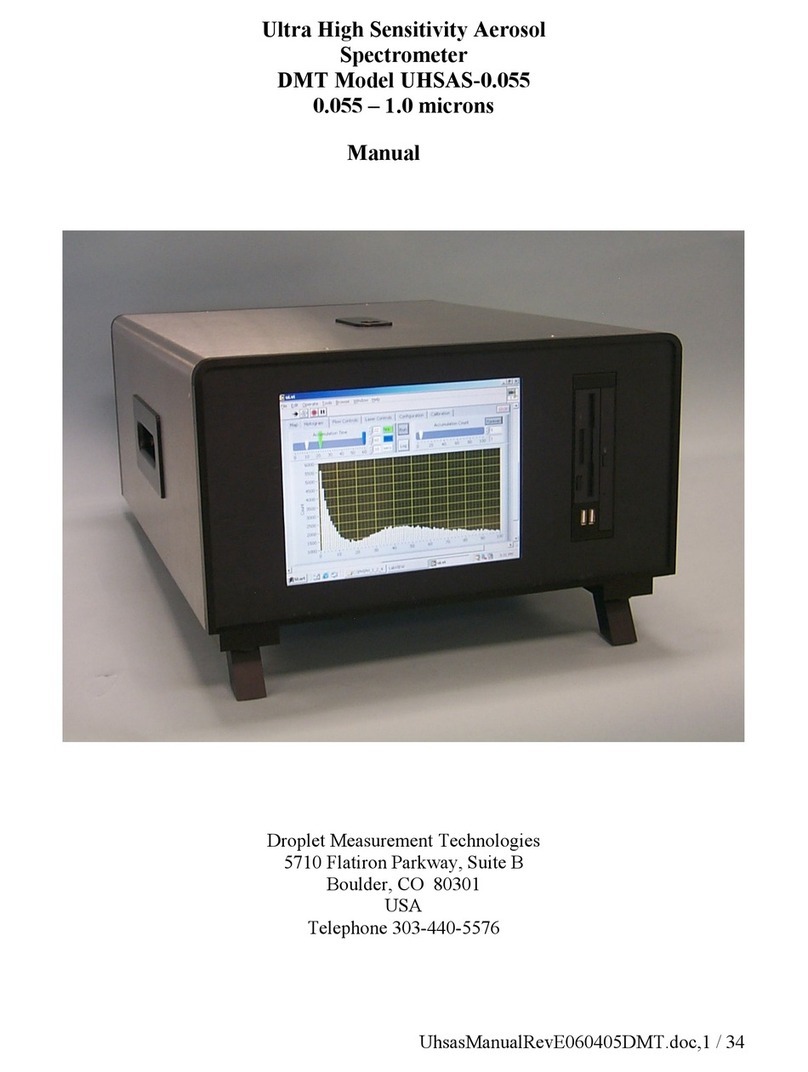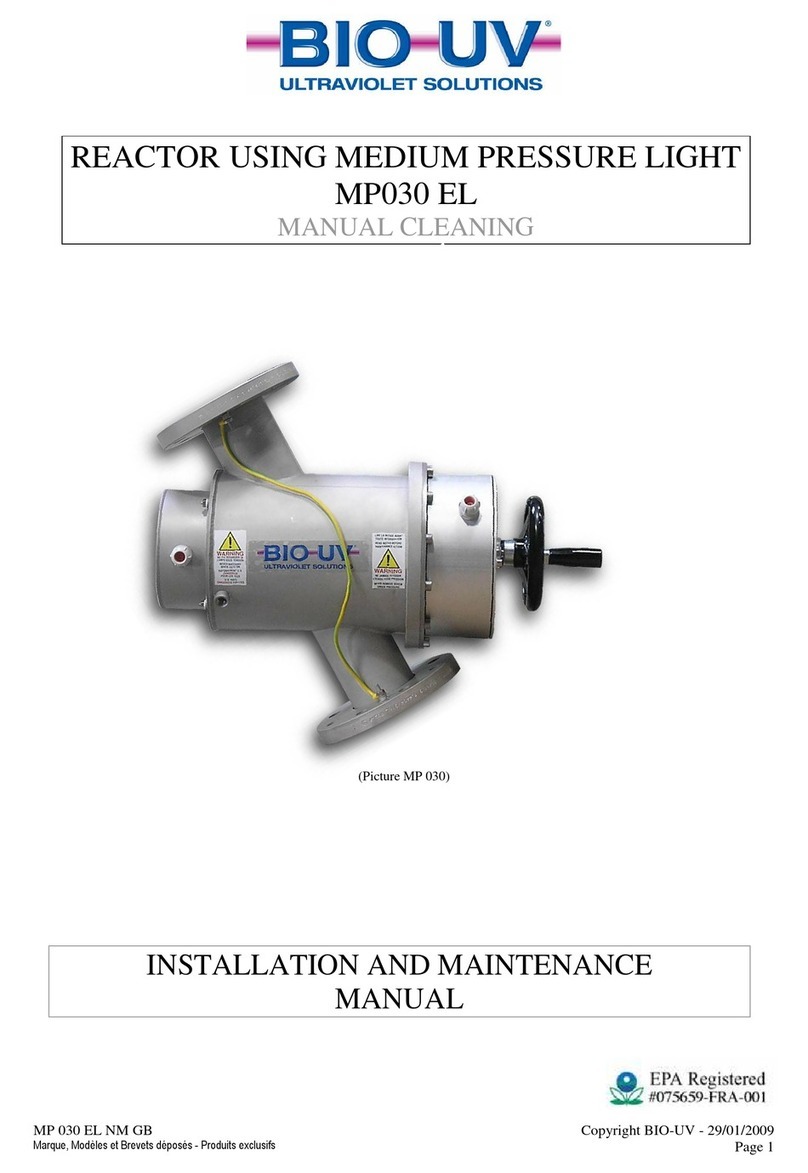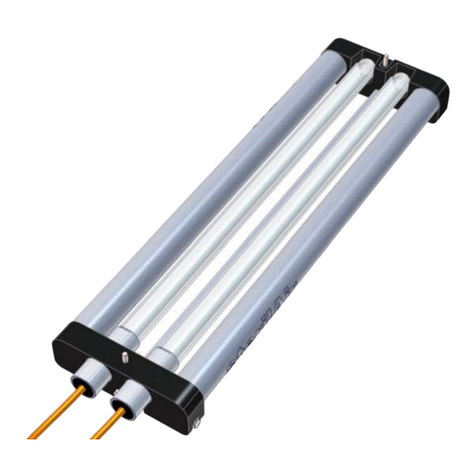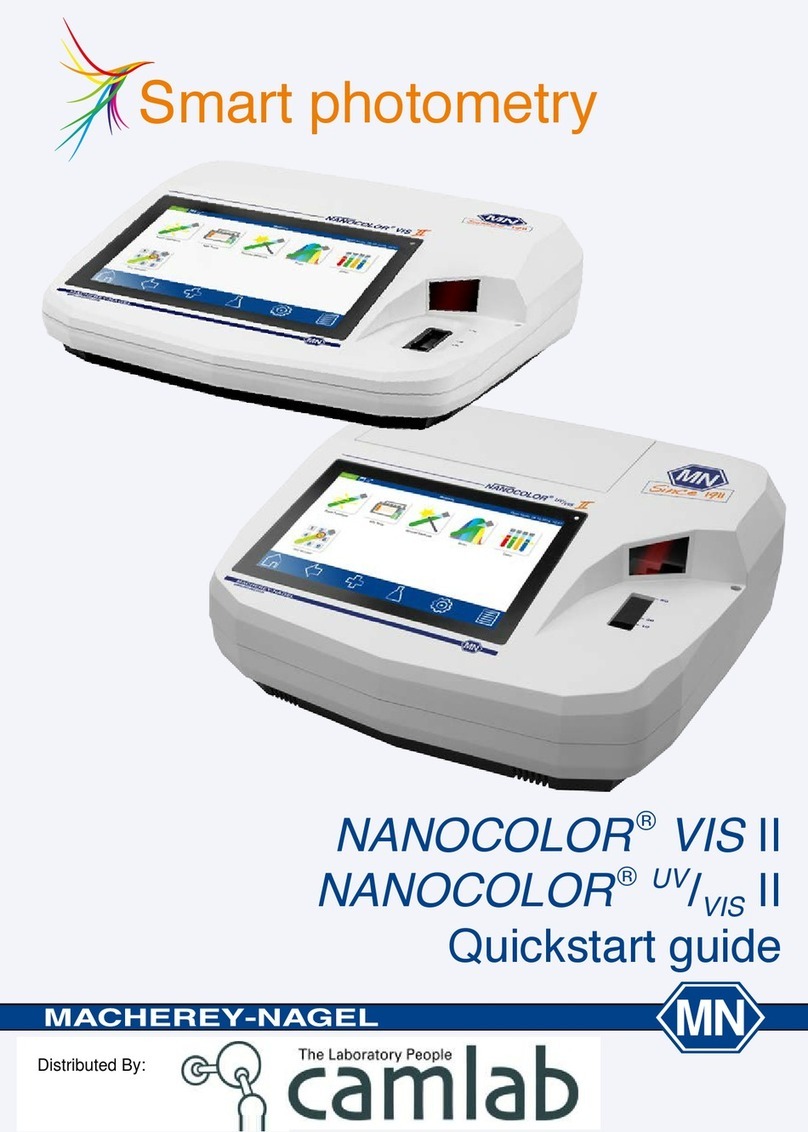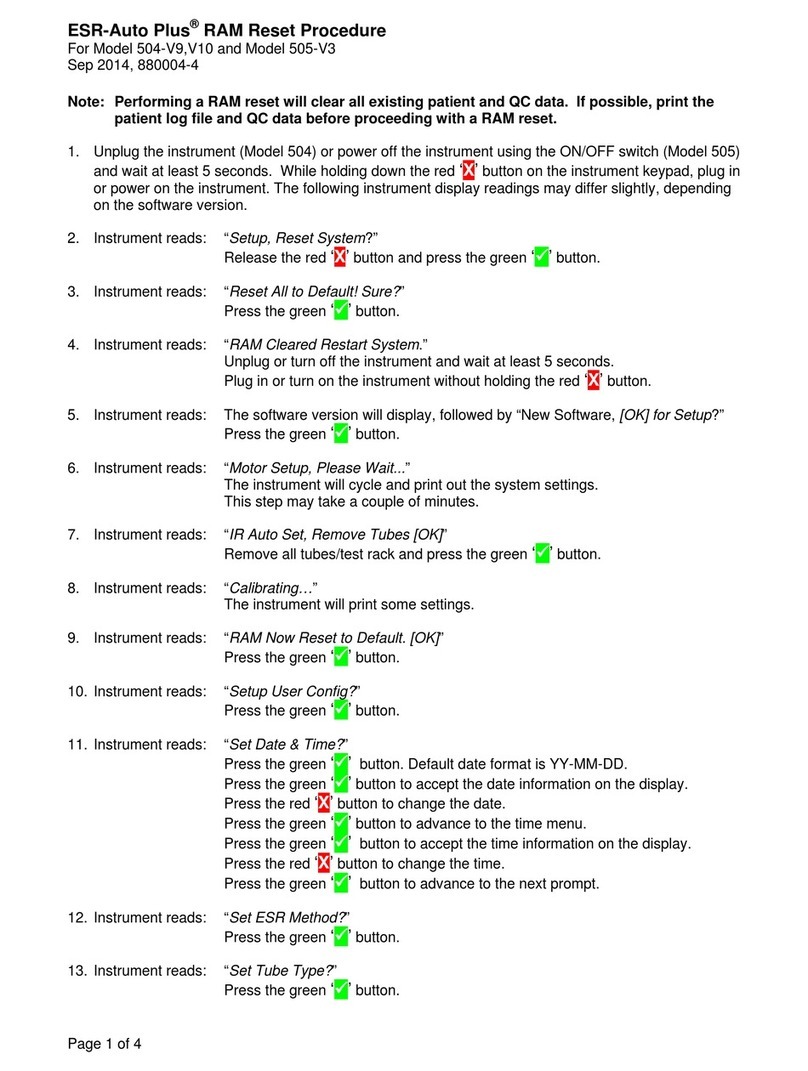Biorep Technologies PERI-4.2 User manual

1
PERIFUSION SYSTEM
MODEL No: PERI-4.2
______________________________________________________
USER MANUAL
______________________________________________________

2
© BIOREP 2016 (r10-22)
TABLE OF CONTENTS
1GETTING STARTED .................................................................................................................................................................3
1.1 SYMBOLS USED IN THIS MANUAL...........................................................................................................................................................3
1.2 MACHINE INFORMATION.........................................................................................................................................................................3
1.3 CONTACT INFORMATION.........................................................................................................................................................................3
1.4 SAFETY INFORMATION............................................................................................................................................................................4
1.5 SITE PREPARATION .................................................................................................................................................................................5
1.6 PACKING LIST .........................................................................................................................................................................................5
2INTRODUCTION........................................................................................................................................................................6
3MACHINE PARTS IDENTIFICATION..................................................................................................................................7
4ACCESSORIES............................................................................................................................................................................9
4.1 TUBING SET ............................................................................................................................................................................................9
4.2 PERIFUSION CHAMBER............................................................................................................................................................................9
4.3 PERIFUSION CHAMBER AUXILIARY RACK ..............................................................................................................................................10
4.4 PERIFUSION NOZZLES ...........................................................................................................................................................................10
4.5 COLLECTION WELL-PLATES...................................................................................................................................................................10
4.6 BIO-GEL P-4.........................................................................................................................................................................................10
4.7 FIBERGLASS PRE-FILTERS......................................................................................................................................................................10
5PERIFUSION SYSTEM OVERVIEW....................................................................................................................................11
5.1 BASIC PERIFUSION SCHEMATIC.............................................................................................................................................................11
5.2 VALVE MANIFOLD................................................................................................................................................................................12
5.3 PERISTALTIC PUMP................................................................................................................................................................................14
5.4 PERIFUSION CHAMBER ..........................................................................................................................................................................14
5.5 COLLECTION TRAY................................................................................................................................................................................15
6PERIFUSION SYSTEM BASICS............................................................................................................................................16
6.1 POWER-UP............................................................................................................................................................................................16
6.2 LOGGING IN..........................................................................................................................................................................................17
6.3 MAIN MENU..........................................................................................................................................................................................18
6.4 TEST PAGE ............................................................................................................................................................................................19
6.5 SETTINGS ..............................................................................................................................................................................................21
7PERIFUSION OPERATION (PROTOCOL WIZARD) ......................................................................................................22
7.1 CHAMBER POSITIONING.........................................................................................................................................................................22
7.2 PROTOCOL.............................................................................................................................................................................................22
7.3 SYSTEM SETUP ......................................................................................................................................................................................23
7.4 CHAMBER SETUP ..................................................................................................................................................................................24
7.5 PERIFUSION TUBING SETUP...................................................................................................................................................................24
7.6 PRIMING................................................................................................................................................................................................25
7.7 CELL LOADING......................................................................................................................................................................................25
7.8 CHAMBER POSITIONING.........................................................................................................................................................................26
7.9 TEMPERATURE CONTROL ......................................................................................................................................................................26
7.10 PROTOCOL EXECUTION..........................................................................................................................................................................27
7.11 PROTOCOL EXAMPLES ..........................................................................................................................................................................29
8FINALIZING THE EXPERIMENT........................................................................................................................................31
8.1 COLLECTING THE CELLS........................................................................................................................................................................31
8.2 CLEANING THE SYSTEM.........................................................................................................................................................................32
9REPORT......................................................................................................................................................................................32
10 CUSTOMER SERVICE............................................................................................................................................................33

3
1 Getting Started
1.1 Symbols Used in this Manual
The lightning flash with arrowhead symbol, within an equilateral triangle, is intended to alert the user to
the presence of dangerous voltage within the machine’s enclosure that may be of sufficient magnitude
to constitute a risk of electric shock.
The exclamation point within an equilateral triangle is intended to alert the user to the presence of
important information in the literature that accompanies the device.
This symbol warns of moving parts that may cause personal injury.
This symbol is used when two people are needed to do the task.
1.2 Machine Information
In the spaces provided below, record the Model and Serial No. located on the rear panel of your machine.
Model No. __________________ Serial No.______________________
RETAIN THIS INFORMATION FOR FUTURE REFERENCE.
1.3 Contact Information
Biorep Technologies, Inc.
15804 NW 57th Avenue
Miami Lakes, FL 33014
www.biorep.com
Tel: 305-330-4449
Fax: 305-330-4402
WARNING:
Please, read this section before unpacking, installing or
operating this machine.

4
1.4 Safety Information
PLEASE READ AND OBSERVE ALL WARNINGS AND INSTRUCTIONS GIVEN IN THIS USER’S
MANUAL AND THOSE MARKED ON THE UNIT.
RETAIN THIS BOOKLET FOR FUTURE REFERENCE.
DO NOT REMOVE THE MACHINE’S COVER OR YOU MAY BE EXPOSED TO DANGEROUS
VOLTAGE. REFER SERVICING TO QUALIFIED PERSONNEL ONLY.
TO REDUCE THE RISK OF FIRE OR ELECTRIC SHOCK, DO NOT EXPOSE THIS DEVICE TO RAIN
OR MOISTURE. DANGEROUS HIGH VOLTAGES ARE PRESENT INSIDE THE ENCLOSURE.
READ AND UNDERSTAND HOW MOVING PARTS ARE CONTROLLED BEFORE OPERATING THE
MACHINE. KEEP YOUR FINGERS AWAY FROM MOVING PARTS; NEGLECTING TO DO SO MAY
CAUSE PERSONAL INJURY.
READ AND FOLLOW THESE INSTRUCTIONS:
1. Keep these instructions for future reference and heed all warnings stated in this manual.
2. Do not block any ventilation openings. Install the machine in accordance with the manufacturer’s
instructions. See Site Preparation in section 1.5 for details.
3. Do not defeat the safety purpose of the polarized or grounding-type plug. A polarized plug has two blades
with one wider than the other. A grounding-type plug has two blades and a third grounding prong, which
is provided for your safety. If the provided plug does not fit into your outlet, consult an electrician for
replacement of the obsolete outlet or contact Biorep Technologies, Inc. at (305) 330-4449.
4. Protect the power cord, the power entry module, and the plug from being walked on or pinched to avoid
damaging them.
5. Refer all servicing of the machine to qualified personnel. Servicing is required when the apparatus has
been damaged in any way, for example: the power-supply cord or plug is damaged, liquid has been
spilled or objects have fallen into the apparatus, or if the apparatus has been exposed to rain or moisture,
has been dropped, or does not operate normally for any reason.
WARNING:
DO NOT SKIP READING THIS SECTION.

5
1.5 Site Preparation
This machine is intended to work in a controlled laboratory environment. In order to properly place the machine,
please refer to the figure below. The machine has a ventilation opening in the rear, which should not be blocked.
A 12.7cm (5.0 in) clearance is recommended between the back of the machine and any obstacle. Bench-space
required is 49cm (19.3 in) x 65cm (25.6 in).
Figure 1: Site Preparation
1.6 Packing List
The following items are included with the purchase of a Perifusion system:
Qty
Reference
Description
1
86610610
Power Cord
12
PERI-CASSETTE
Pump cassettes
12
PERI-CHAMBER
Perifusion Chambers
1
PERI-TUB-12
Two-Stop Tygon Tubing Set (pack of 12)
1
PERI-TUB-040
Silicone Tubing (50 ft)
1
PERI-FILTER
Fiberglass Pre-filters (pack of 10)
1
PERI-BEADS-20
Bio-Gel P-4 Gel (20 grams)
1
PERI-RACK
Perifusion Chamber Rack
1
12885T21
Single Hole Punch
1
PERI-96-PLATE
96 well-plate
15
PERI-NOZZLE
Dispensing Nozzle
1
TUB-16
Size 16 Tubing for cooling tray
50
PERI-ORING
Perifusion Chamber O-rings
12
PERI-CLIPS
Pack of Clips
Table 1: Packing List

6
2 Introduction
Congratulations on your purchase of the Biorep Perifusion system. This is the newest generation of a product that
has received countless hours of development to include all the features necessary to perform the most controlled
and precise stimulated cell secretion experiments in the field. You will not be disappointed with the value and
efficiency this machine will bring to your research.
The Perifusion system accurately stimulates and collects the secretions of pancreatic islets in-vitro. Its use has
been extended to include the measurement of secretions of differentiated cells derived from pancreatic progenitor
stem cells. Coupled to a tandem mass spectrometer, the Perifusion system can help identify molecules secreted
during the stimulation of pancreatic islets.
The machine accurately controls temperature, flow, stimulus source and sample collection in up to 8 channels in
parallel. The Perifusion system is designed to execute pre-programmed protocols that can last for hours and
require several sample trays.
This User Manual is intended to be used by scientists, researchers, and technicians who have received training in
cell perifusion methods and technologies. This document contains the necessary information for installing and
operating the machine. However, it is not meant to provide scientific guidance on perifusion protocols. Any
perifusion protocols encountered in this manual will be solely for the purpose of illustration of machine operation
and should not be interpreted otherwise.
3 Perfusion
5 Purification
6 Perifusion
7 Cell Transport
8 Transplant
1 Donnor
2 Organ Transportation
4 Isolation
Figure 2 Perifusion System in the islet isolation process

7
3 Machine parts identification
Figure 3: Perifusion system, side view
Figure 4: Perifusion system, front view

8
Figure 5: Perifusion system, back view
1. Removable source holder
2. 32 (8 x 4) valve manifold for source handling
3. 12 Channel peristaltic pump (Main pump)
4. Temperature control inlet/outlets (x6)
5. Perifusion chamber
6. Sample collection tray
7. Alarm buzzer
8. Tray cooling diaphragm pump
9. Power cable
10. Incubator cover
11. 12” Touch-Screen
12. E-Stop
13. Orbitor Enable (Optional Add-On)
14. Nameplate
15. USB 2.0 Port 1
16. USB 2.0 Port 2
17. RJ45 LAN Port
18. Power Entry Module

9
4 Accessories
A complete set of accessories is included with the machine. For ordering additional or replacement accessories
please consult our webpage www.biorep.com or contact one of our sales representatives at (305) 330-4449.
4.1 Tubing Set
The Perifusion tubing set delivers the stimulus to the cell chamber while minimizing dead volume. The perifusion
tubing set is made out of 2 types of tubing: A- Connection tubing, which is for the perifusion fluid handling system
(source-manifold, manifold-pump, pump-chamber); and B- the peristaltic pump tubing, which provides the precise
resolution needed in perifusion experiments. A set of each type is included with this machine.
Item
Description
Reference
A
Silicone Tubing; 0.040in ID, 0.085in OD
89068-462
B
Two-Stop Tubing (Tygon R-3603) (orange-green);
0.015in ID, 0.035in WT;
PERI-TUB-12
Table 2: Items Included in the Perifusion Tubing Set
4.2 Perifusion Chamber
The Perifusion chamber is where all cell reactions will take place. Substances will be delivered through the inlet
tube, cells contained in the chamber will react to the substances, and secretions will come out the outlet tube for
collection. A new system includes 16 perifusion chambers.
1- Inlet tube
2- Top cap
3- Top O-Ring
4- Cell chamber
5- Bottom O-Ring + Filter
6- Bottom cap
7- Outlet tube
Figure 6: Perifusion Chamber

10
4.3 Perifusion chamber auxiliary rack
The auxiliary rack is included with every Perifusion system
to assist in the preparation of the Perifusion chambers. The
rack can hold up to 8 chambers at a time for cell loading
outside the machine. This allows the scientist to do the
preparation away from the machine in a more comfortable
position.
Figure 7: Perifusion Chamber Rack
4.4 Perifusion Nozzles
The Biorep® Perifusion Nozzle reduces the droplet size dispensed into the 96-well
plates. Small droplets (~4µL) ensure optimal resolution of the dynamic insulin
response.
Figure 8: Perifusion Nozzles
4.5 Collection well-plates
The collection well-plate is where the cell secretions and
the perfusate are collected for analysis. The Perifusion
system was designed to work with standard 96 well-plates,
and now has the ability to use high capacity, deep well
plates for longer experiments.
Figure 9: Collection Well-plate
4.6 Bio-Gel P-4
The Bio-Gel P-4 polyacrylamide beads are used at the time
of Perifusion chamber setup. They are used contain the
cells and prevent clogging of the filter.
See appendix A for beads solution preparation.
Figure 10: Bio-Rad polyacrylamide beads
4.7 Fiberglass pre-filters

11
A fiberglass filter sheet is included with every perifusion
system. A hole puncher (included) is used to make round
cut-outs of the filter sheet to place inside the perifusion
chamber during its set-up. The purpose of this filter is to
retain the chamber contents while allowing the flow of the
perfusate.
Figure 11: Hole Punch
5 Perifusion system overview
5.1 Basic Perifusion schematic
The following schematic shows the basic functional elements and stages of the Perifusion system. Potential users
should become familiar with all the components of the system before attempting to operate the machine.
Figure 12: Basic Perifusion Schematic
1. SOURCES: Up to eight different test solutions can be used as sources in a single experiment. These sources
can be administered either manually by the user or automatically by the machine through the valve manifold.
Sources are contained inside the enclosure’s temperature controlled environment.
2. VALVE MANIFOLD: An automated valve manifold handles the source selection for each channel. The
manifold has 8 input channels (1, 2, 3…8) and four output channels A, B, C and D. Each output channel is tripled,
for a total of 12 output connections. A detailed description can be found in section 5.2.
3. MAIN PUMP: A high precision, 12- channel peristaltic pump moves the test compounds from the source,
through the manifold, to the Perifusion chambers and out to the well plate.
4. PERIFUSION CHAMBER: The Perifusion chambers hold the cells to be stimulated. The input to each chamber
is the source selected by the manifold for its respective channel. The output will contain the secretions and
metabolites to be collected on the well plate. Up to eight Perifusion chambers can be used in parallel.
5. TEMPERATURE CONTROL: All the test sources are housed in the same incubator enclosure as the
Perifusion chambers to provide a controlled temperature environment for the entire process. A multi-point
circulation design ensures temperature uniformity within 1ºC around the Perifusion chambers.

12
6. COLLECTION: The perfusate is collected in a well plate for further analysis. The collection tray moves
automatically accordingly to the number of active columns (Perifusion chambers) and the pre-set sampling rate.
The collection tray can hold deep and standard 96 well plates; be sure to place the included spacer adapter inside
the tray to use it with standard plates.
7. REFRIGERATION: The collection tray can be refrigerated to avoid degradation of the analytes in the perfusate
during experiments. This is done by a dedicated diaphragm pump.
5.2 Valve Manifold
The valve manifold was designed to automate the selection of the stimulus. Manual source changing is not only
time consuming for the user, but it also increases the potential for artifacts on the results. Manual source
changing requires the user to pause the machine to avoid drawing air into the system, but cell metabolism cannot
be paused! Cells will continue to metabolize and, when flow is resumed, a “spike” of metabolites will be generated
at the output.
Minimizing this problem was a priority at the time of developing the new Perifusion system. The result was a self
contained, 32 valves, 8-in to 4-out manifold. The manifold can change the source for every channel “on-the-fly”
(milliseconds), eliminating the need for pausing the system. It also eliminates the need for external sources
requiring a separate heater; the sources can be housed inside the machine, allowing for a better temperature
control.
In conjunction with the ability to perform automated protocols, the valve manifold provides a hands-off solution
from start to finish of a Perifusion experiment. The user can now leave the machine unattended and have the
certainty that source changes will be made flawlessly every time.
Figure 13: Valve Manifold
Understanding the valve manifold is key for a proper experiment setup. Inputs are located at the bottom of the
manifold block, starting with input 1at the left (see fig. 13). Sources should be connected to the input ports
according with this numeration.
There are four output channels (A, B, C, D) located
in the front of the manifold, starting with channel Aat
the top. Each output channel can be split into 2 using
a wye “Y” fitting, or split into 3 using a cross “X” fitting.

13
Manifold states are represented by the letter and number combination “CHANNEL-SOURCE” for each of the four
channels: An, Bn, Cn, Dn, where n= 0-8, depending on the selected source (“0” represents a closed channel).
Example: The manifold state: A2, B3, C8, D0, means output Awill be from source 2, output Bwill be from source
3, output Cfrom source 8and the outputs of channel Dis Inactive/closed.
Automated protocols will have a manifold state defined for each step. A detailed description of protocol creation
can be found in section 7.2.

14
5.3 Peristaltic pump
The sources are pumped from their containers through the open valves of the manifold by the main pump. The
main pump is a 12 roller, high precision peristaltic pump, capable of handling up to 12 channels simultaneously,
providing accurate and identical dispensing across channels.
Figure 14: Peristaltic Pump (Only 8 channels shown)
The main body of the pump (1), is fixed to the machine chassis. The special tubing (3) setup is facilitated by
individual cartridges (2). Cartridges snap in and out of the pump by pressing on the release lever (4). A detailed
description of tubing setup can be found in section 7.5.
5.4 Perifusion chamber
Sources delivered by the pump will react with the cells inside the perifusion chamber. The cells are contained
inside the chamber within a gel bead matrix. A fiberglass filter is used as a bottom layer before the output.
Secretions will come out the outlet tube for collection in the well-plate. The internal volume is 275 µL. The
chamber is translucent to allow visualization of its contents. It is designed to fit a micro-centrifuge tube for easy
cell recovery. This is important at the time of data normalization. A detailed description of the chamber setup for
an experiment can be found in section 7.4.
1. Top cap
2. O-ring
3. Cell chamber
4. Fiberglass filter
5. Bottom cap
6. Micro-centrifuge tube

15
Figure 15: Perifusion Chamber and collection tube
5.5 Collection tray
Figure16: Collection Tray
The collection tray (1) holds and positions the well-plate (2) for automated collection of the perfusate and cell
secretions according to programmed time intervals. The collection tray can be used in a Horizontal or Vertical
configuration with respect to the positioning mechanism (3). In addition, the collection plate can be refrigerated by
circulating fluid through the available ports (4).
The Perifusion system features a new deep collection tray that allows the use of large capacity 96 well plates. To
use standard capacity well plates, insert the included spacer adapter into the tray.
When inserting the well-plate on the collection tray, make sure that well A1 is in the position
shown on Figure 15. This will ensure that the dispensing sequence will start at this point,
avoiding any confusion at the time of analysis.

16
6 Perifusion System Basics
Control and operation of the Perifusion system is done through the touch-screen interface. This type of interface
eliminates the need for an external keyboard or mouse device and provides a visual and intuitive interaction with
the user. The operator should familiarize himself/herself with the different screens, features, and controls of the
interface before attempting to operate the machine during an actual perifusion.
Anyone who will operate and/or supervise the use of this machine should read and
understand this section in its entirety.
This machine has been designed with alarm features that will help the user identify and
correct potential problems. Alarm messages will be displayed at the bottom of the screen. A
detailed description of the different alarms can be found later in this manual.
6.1 Power-Up
The machine’s main power switch and fuse-box are located on the back of the machine, above the power entry
module. Connect the power cord (provided in the accessory box) to the module and then plug it into a 115/230
VAC outlet depending on your location. The red box in the module displays the voltage rating intended for your
machine.
Figure 17: Power Module
This screen will appear after a successful system boot-up. Touch
anywhere on the screen to continue.
Figure 18: Power-up screen

17
6.2 Logging In
The Login Page allows you to Log into your password
protected user account. The user account saves your
protocols, reports, and the preferences of your
experiments; it also saves time by pre-filling some
frequently used fields during the experiment process
and during reporting.
The first step is creating a user account. To create a
new user account, press the Add User Button.
When the “Add User” button is pressed, the “New User
Account” fields on the right of the screen will be
enabled. Upon clicking on any field a pop-up keyboard
will appear. Enter a unique username and password
using the keyboard and press “Accept”. Click Save to
create the user.
Now you will be able to find your User name on the
drop down list at the top left. The next time you do a
Perifusion experiment, just select your user from the
list, enter your password and press “Login”.
Figure 19: Login page

18
6.3 Main Menu
Figure 20: Main Menu
Once logged in, you will arrive at the Main Menu page. On this page you can start an experiment, via the
“Protocol Wizard”; configure the settings of the machine, or manually control the different sub-systems of the
machine via the “Test Page”.
In this page you will also see the User account, the Software Version installed in your perfusion machine, and the
machine Status Bar at the bottom. The Status Bar will display any alarms or important messages related to the
function of the machine.
You can also end the session from this page either by logging out of your user account or by turning the system
off.
Please do not turn the machine off from the power entry module before being prompted to do
so.

19
6.4 Test Page
Figure 21: Test Page
The best way to get acquainted with the different sub-systems of the Perifusion machine is by playing around in
the Test Page. You can test the alarm buzzer by pressing the “Test Buzzer” button, or confirm the proper sensing
of the tray orientation by looking at the icon on the top right. This icon should change when the tray is moved
between “Landscape” and “Portrait” orientations.
MOTION: The motion controls manipulate the position of the tray
by enabling direct access to the motors. Simply touch any
direction arrow to move the tray in the desired direction. You can
control the speed of the movement by changing the “Velocity
(Jog)” value. An X,Y position indicator is provided in case you
need to record the position value for reference. Press HOME to
return to the starting position.
Figure 22: Motion Controls

20
TEMPERATURE: The temperature systems can be
tested by these controls. The “HEATER” button enables
the heater and the convection fans. The incubator PV
(Present Value) will be displayed below. The tray cooling
pump can be turned on by pressing the “Tray Pump”
button. The tray temperature will be displayed below
Figure 23: Heater controls
FLUIDICS: The fluid handling manifold is the most
valuable sub-system for automating a Perifusion
experiment. It is composed by the precision peristaltic
pump, and the 8 to 4 manifold. The pump can be tested
by assigning a value to the “Pump Flow-rate”box. The
state of each of the 32 individual valves on the perifusion
can be manually changed by touching the corresponding
LED indicator on the graphical array. An open valve is
represented by an ON indicator. It is not recommended
that you open all valves at once.
Figure 24: Valve controls
At any point, press the BIOREP logo to return to the MAIN MENU
Figure 25: Return to Main Menu
Table of contents
Other Biorep Technologies Laboratory Equipment manuals
Popular Laboratory Equipment manuals by other brands
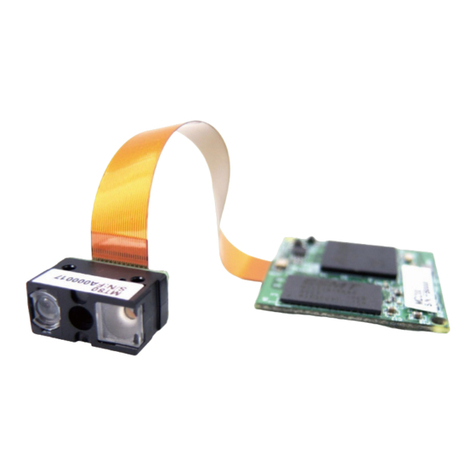
Marson
Marson MT80 Integration guide
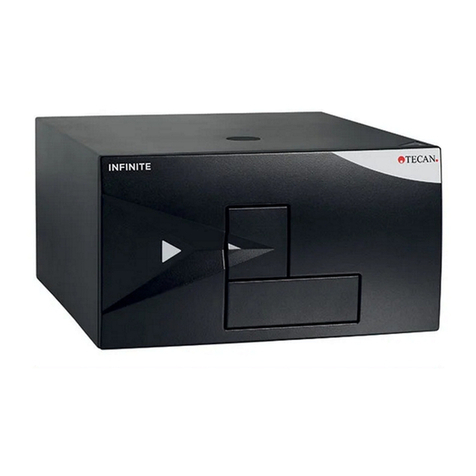
tecan
tecan infinite 200 Instructions for use
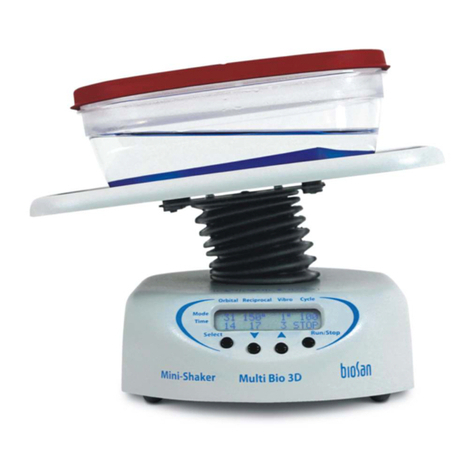
Biosan
Biosan Multi Bio 3D operating manual

Cost Effective Equipment
Cost Effective Equipment Apogee 450 Operation manual
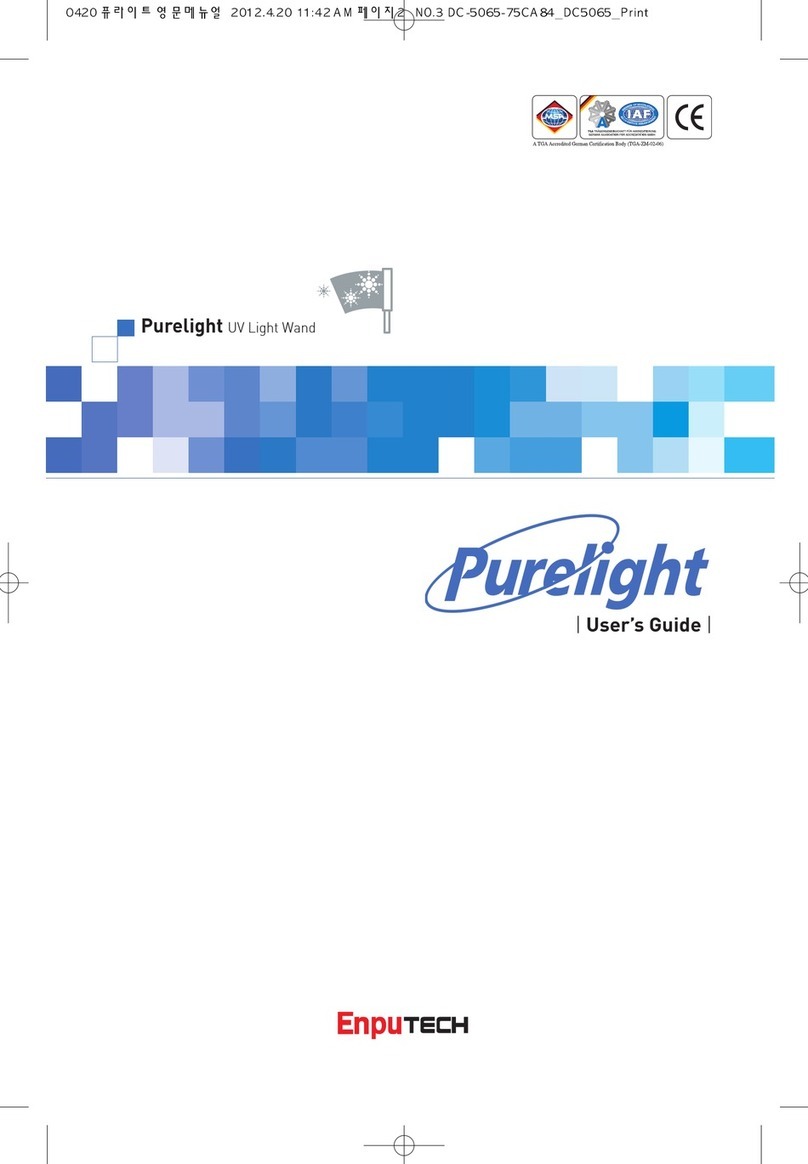
Enputech
Enputech Purelight Series user guide
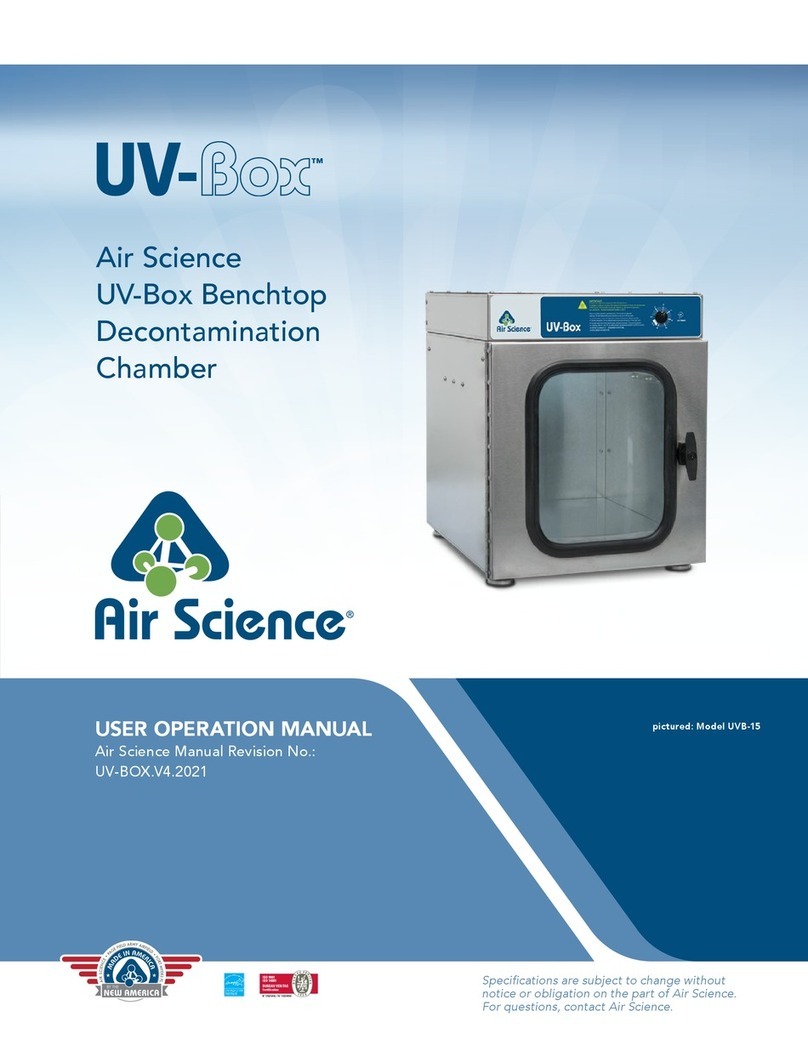
Air Science
Air Science UV-BOX UVB-15 User's operation manual
